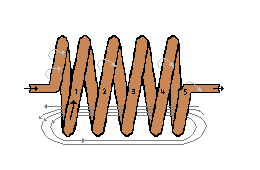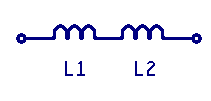
Introduction
Chapter 1 - Electricity
Chapter 1.2 - The Numbers
Chapter 2 – Sharing and Bonding
Chapter 3 - Voltage
Chapter 3.2 – Voltage Static
Chapter 3.3 - Batteries
Chapter 3.4 – Solar - Others
Chapter 4 - Resistance
Chapter 4.2 – Parallel Resistance
Chapter 4.3 – Voltage Dividers
Chapter 5 - Semiconductor
Chapter 5.2 - PNP NPN Junctions
Chapter 6 – AC and Hertz
Chapter 7 - Magnetism
Chapter 7.2 - Inductors
Chapter 8 - Capacitor
Chapter 9 - IC's and Amplifier
Chapter 10 - 555 Timer
Chapter 11 - Logic
Chapter 12 - Power Supply
|
|
 When inductors are in series in a circuit, the current will flow equally through
the series of inductors. The total inductance for the series is calculated by
adding the values of all series inductors together. This is similar to way that
series resistors are calculated.
The formula for inductor in series is L-equivalent = L1 + L2.
If L1 equals 3 millihenrys and L2 equals 2 millihenrys the total is 5 millihenrys.
When inductors are in series in a circuit, the current will flow equally through
the series of inductors. The total inductance for the series is calculated by
adding the values of all series inductors together. This is similar to way that
series resistors are calculated.
The formula for inductor in series is L-equivalent = L1 + L2.
If L1 equals 3 millihenrys and L2 equals 2 millihenrys the total is 5 millihenrys.